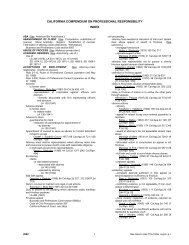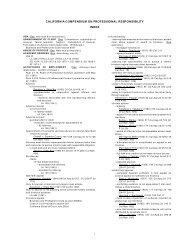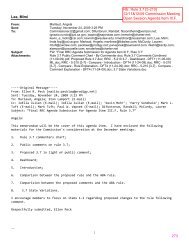Sorted by Commenter - Ethics - State of California
Sorted by Commenter - Ethics - State of California
Sorted by Commenter - Ethics - State of California
Create successful ePaper yourself
Turn your PDF publications into a flip-book with our unique Google optimized e-Paper software.
[5] An agreement may not be made whose terms might induce the lawyer<br />
improperly to curtail services for the client or perform them in a way<br />
contrary to the client’s interest. For example, a lawyer should not enter<br />
into an agreement where<strong>by</strong> services are to be provided only up to a<br />
stated amount when it is foreseeable that more extensive services<br />
probably will be required, unless the situation is adequately explained<br />
to the client. Otherwise, the client might have to bargain for further<br />
assistance in the midst <strong>of</strong> a proceeding or transaction. However, it is<br />
proper to define the extent <strong>of</strong> services in light <strong>of</strong> the client’s ability to<br />
pay.<br />
Prohibited Contingent Fees<br />
[6] Paragraph (d)(1) does not preclude a contract for a contingent fee for<br />
legal representation in connection with the recovery <strong>of</strong> balances past<br />
due under child or spousal support or other financial orders because<br />
such contracts do not implicate the same policy concerns.<br />
Payment <strong>of</strong> Fees in Advance <strong>of</strong> Services<br />
[7] Every fee agreed to, charged, or collected, including a fee that is a<br />
lawyer’s property on receipt under paragraph (e)(1) or (e)(2), is subject<br />
to Rule 1.5(a) and may not be unconscionable.<br />
[8] Paragraph (e)(1) describes a true retainer, which is sometimes known<br />
as a “general retainer,” or “classic retainer.” A true retainer secures<br />
availability alone, that is, it presumes that the lawyer is to be<br />
additionally compensated for any actual work performed. Therefore, a<br />
payment purportedly made to secure a lawyer’s availability, but that will<br />
be applied to the client’s account as the lawyer renders services, is not<br />
a true retainer under paragraph (e)(1). The written true retainer<br />
RRC - 4-200 [1-5] - CLEAN Landscape - DFT11 (12-14-09).doc<br />
agreement should specify the time period or purpose <strong>of</strong> the lawyer’s<br />
availability, that the client will be separately charged for any services<br />
provided, and that the lawyer will treat the payment as the lawyer’s<br />
property immediately on receipt.<br />
[9] Paragraph (e)(2) describes a fee structure that is known as a “flat fee”.<br />
A flat fee constitutes complete payment for specified legal services,<br />
and does not vary with the amount <strong>of</strong> time or effort the lawyer expends<br />
to perform or complete the specified services. If the requirements <strong>of</strong><br />
paragraph (f)(2) are not met, a flat fee received in advance must be<br />
treated as an advance for fees. See Rule 1.15.<br />
[10] If a lawyer and a client agree to a true retainer under paragraph (e)(1)<br />
or a flat fee under paragraph (e)(2) and the lawyer complies with all<br />
applicable requirements, the fee is considered the lawyer’s property on<br />
receipt and must not be deposited into a client trust account. See Rule<br />
1.15(f). For definitions <strong>of</strong> the terms “writing” and “signed,” see Rule<br />
1.0.1(n).<br />
[11] When a lawyer-client relationship terminates, the lawyer must refund<br />
the unearned portion <strong>of</strong> a fee. See Rule 1.16(e)(2). In the event <strong>of</strong> a<br />
dispute relating to a fee under paragraph (e)(1) or (e)(2) <strong>of</strong> this Rule,<br />
the lawyer must comply with Rule 1.15(d)(2).<br />
Division <strong>of</strong> Fee<br />
[12] A division <strong>of</strong> fees among lawyers is governed <strong>by</strong> Rule 1.5.1.<br />
243












![Proposed Rule 4.1 [N/A] “Truthfulness in Statements to Others” - Ethics](https://img.yumpu.com/19037854/1/190x245/proposed-rule-41-n-a-truthfulness-in-statements-to-others-ethics.jpg?quality=85)



